#i know Owens character name but im still calling him Owen Wilson
Text
No cause when Loki returns to Owen Wilson i swear Owen is gonna be like ”why didnt you Wait for me?” And Loki is gonna be like ”cause you didnt trust me” aND OWEN IS GONNA BE LIKE ”I do trust you and im sorry i didnt show that before” AND IM GONNA CRY AAAAAAA

#loki series#Loki layfeyson#mobius#owen wilson#i know Owens character name but im still calling him Owen Wilson#AND IM SO SAD THAT THEY WONT EVER BE CANON#BUT MAYBE THERE’LL BE SOME FLIRTING#PLEASE GOD LET THERE BE FLIRTING AND
8 notes
·
View notes
Text
John Torrington: A Portrait of the Stoker as a Young Man
(Previous posts 1, 2, 3, 4, 5, 6, 7, 8)
Different forms of art have depicted Torrington in different ways. In my last post I discussed how in music Torrington seems to be depicted as either some sort of restless spirit or reanimated man-out-of-time, with a focus on his death and the eerie undead appearance of his mummified body. There’s not much of a focus on what he was like when he was alive, with the inspiration for these works coming from the image of his dead body. Sadly, we don’t have any pictures of what he looked like when he was alive, but that doesn’t mean people haven’t tried to imagine it. In fact, Torrington’s depiction in visual artworks often focus more on what he was like when he was alive, with various attempts at reconstructing what he may have looked like before he died and was buried on Beechey.
One of the first attempts at recreating what he may have looked like comes from the Nova documentary “Buried in Ice.” At the very end of the documentary, there are artistic reconstructions of Torrington, Hartnell, and Braine. I’m not entirely sure who the artist was, but the credits list an illustrator, Wayne Schneider, and he may have been the one to draw these. I can’t find the illustrations outside of the documentary, so please forgive the bad quality of the screenshot I had to use below.
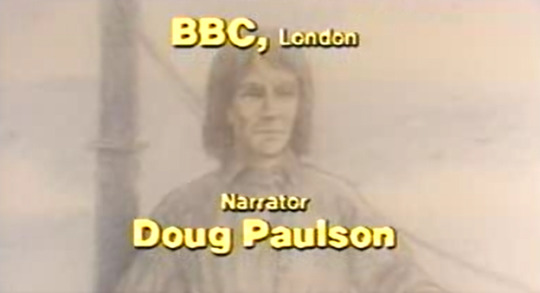
Here we have a John Torrington who looks aged before his time. He was only twenty when he died, but judging by the state of his lungs, he probably had a hard life, so he may have looked much older than his years. This is a very serious-looking Torrington, as if he were standing for a portrait or daguerreotype for several minutes and had to stay completely still.
This drawing also gives him almost shoulder-length hair. Owen Beattie was a technical consultant on the documentary, so he probably had a say in what the recreations of the Beechey Boys may have looked like. This makes me think that the hair length shown here is most likely how long his hair actually was. Yes, I know, I’m going on about his hair again, but due to the confusion over what his hair looked like, it tends to vary across artistic depictions, as we shall see.
Another thing of note in this recreation is the noticeable lines around his mouth. In the pictures of Torrington’s mummified body, there are prominent lines around his mouth, but how much of that was due to postmortem distortions and how much would have shown on his face in life is hard to know. The artwork above is not an official forensic facial reconstruction, and even official reconstructions are highly subjective, so this is just one possible interpretation.
There’s another artistic interpretation of Torrington from around the same time. Remember the children’s book Buried in Ice? Well, what’s a kid’s book without some illustrations?
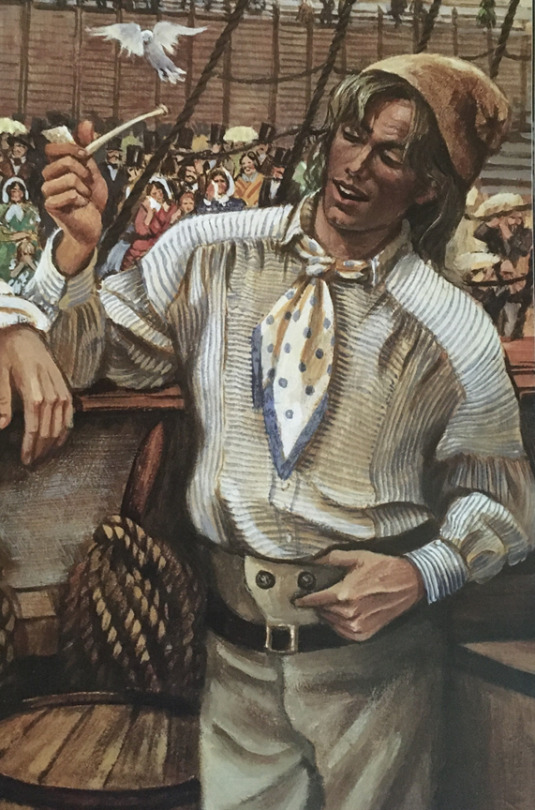
Now that’s the face of a man who got sick of backbreaking, lung-destroying labor in Manchester and said, “Screw it, I’m going to the Arctic.” The hair here is similar to that depicted in the documentary illustration, but the lines around his mouth are softened. The illustrations for this book were done by Janet Wilson, and she brought a liveliness to Torrington’s face that the somber drawing from the documentary greatly lacked. He still has a slightly careworn face, but he looks closer to his actual age. Janet Wilson also did wonderful detailing on the shirt that he was buried in, which he is wearing in her drawing. The kerchief tied around his head in death is here tied around his neck—and I love the inclusion of the blue border around the kerchief, which is not really noticeable in the photos from his exhumation but is noted in the reports on his burial clothes.
I’m fond of this picture because it gives Torrington some personality beyond that of a sad, tragic victim. It makes him seem like a real person who lived, with a bit of a sly and carefree attitude. He also gives off a kind of back alley salesman vibe, like he knows a guy who knows a guy who could sell you a kidney. But I especially like it because he’s smiling as he’s speaking, and after seeing picture after picture of Torrington’s frozen death grimace, I would love to know what he looked like when he smiled.
There’s another artistic reconstruction which I found on YouTube. It’s by artist M.A. Ludwig, who has a YouTube channel (under the name JudeMaris) dedicated to facial reconstructions of various historical figures, including all three of the Beechey Boys. Here’s Ludwig’s interpretation of what Torrington may have looked like:
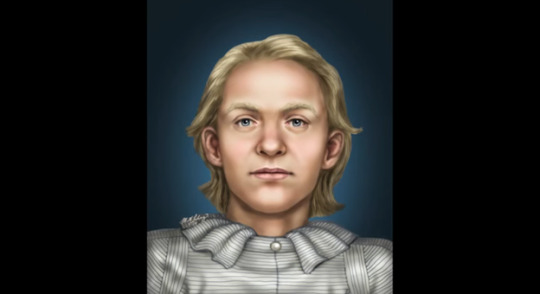
He looks much younger here than in either of the two previous interpretations. This John Torrington looks like a young man ready for adventure, with hopes and dreams of a long future. He has slightly shorter hair in this interpretation, but also, he’s blond. I’ve noticed confusion online about the color as well as length of Torrington’s hair, with a lot of people these days thinking he’s blond. I think that may have something to do with the wood shavings he’s resting on in photos, which as I discussed in a previous post, some people have confused for his hair. I’ve also encountered a few versions of the usual photos of him where the lighting looks different, resulting in the few visible wisps of his hair looking much lighter than official reports have described them. Interestingly, the blond hair makes him look younger and gives him an innocent and almost naïve appearance, completely different from the sly, I’ve-got-a-bridge-to-sell-you Torrington from the children’s book.
Now I’m going to move on to an artist who is well known to Franklinites. Kristina Gehrmann (@iceboundterror) is a German illustrator and graphic artist who specializes in works with a historical or fantasy setting. She has drawn many pictures inspired by the Franklin Expedition, and I have bought several of them from her shop on Etsy, including three different versions of the ships Terror and Erebus sailing in the Arctic or caught in the ice. Currently, those three pictures are on my wall next to a large painting I inherited from my grandparents of two non-Franklin-related ships that I pretend are Terror and Erebus anyway (I call this wall The Boat Place). Gehrmann also wrote and illustrated a graphic novel in German about the Franklin Expedition, Im Eisland, published in three parts and available through Amazon. But if, like me, you don’t speak German, Gerhmann has made an English translation, titled Icebound, available for free here.
Gehrmann has actually drawn two slightly different versions of Torrington, one of which is more like the artistic reconstructions shown above and the other is of a fictionalized Torrington in the graphic novel Im Eisland. I love both of her interpretations, but they are of two different styles. Let’s start with the graphic novel version.

Im Eisland uses a manga-like style, so this version of Torrington is based in that. It gives him a wide-eyed, youthful—and joyful—appearance (when he isn’t dying of consumption, of course). This is the happiest and liveliest Torrington I’ve seen. The manga art style results in some simplified features and a rather modern hairstyle, but there’s nothing wrong with using some artistic license to better convey the personality of a character.
Gerhmann’s other illustration of Torrington is possibly my favorite, even if it might not be the most accurate:

This is a lovely illustration, and it really plays up Torrington’s youth, making him look almost angelic. I’m going to be completely honest—he is very pretty. This version of Torrington is an incredibly handsome young lad, and if Torrington really looked like this, then I think he probably would have been very popular in life. I could go on, but I probably shouldn’t.
I also love the amazing detail on the shirt. You may have noticed some slight variations in these recreations when it comes to his shirt, and I think that’s due to the fact that his shirt looks downright complicated in the few pictures we have of it. There are horizontal stripes and vertical stripes. There’s a high collar and buttons and all these folds that it can be hard to see exactly what it looks like, and unfortunately there were no textile experts present during the exhumation, so there was no one to lay out the shirt and take a closer look at it before redressing and burying him. But every time someone gives their best attempt at figuring out the puzzle that is his shirt, I’m happy, and this one looks very close to how it may have actually looked. My one issue with this picture is that his hair is short and blond, which doesn’t fit the description provided in the autopsy report. But the facial features look true, so I tend to overlook that little nitpick.
This version of Torrington, by the way, is probably the most well-known interpretation. In fact, when you search for John Torrington on Google, this picture crops up:
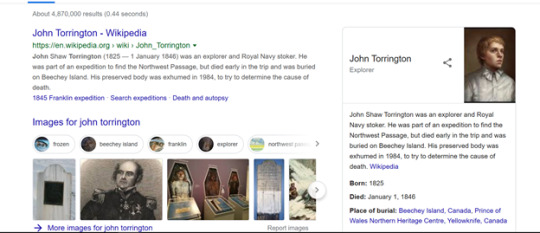
I have even seen online articles about Torrington that use this picture as a reconstruction example. This is in no way an official reconstruction of him, but it is by far the most popular. (And yes, I bought a copy of this picture, too.)
While reconstructions of what Torrington may have looked like when alive are common among artists depicting him, there is some artwork that uses images of his mummified body as inspiration instead. Irish artist Vincent Sheridan has a gorgeous collection of work inspired by the Franklin Expedition. Several of these feature the mummy of John Torrington, including an etching aptly named “John Torrington.”
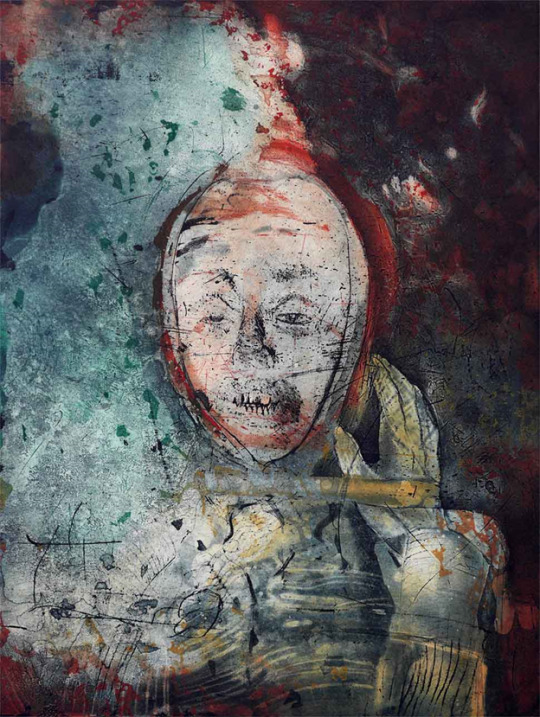
Torrington appears as a ghostly apparition in many of these prints, alongside the repeated imagery of a skull, two very physical signs of the human cost of the expedition. While most of the bodies of the men lost have yet to be found, their bones scattered or buried across King William Island, Torrington’s body is a stark reminder that this tragedy did happen, and that these men did die, not just vanish off the face of the earth. I’ve described Torrington as the poster boy for the expedition before, and here his death seems to represent the death of everyone who sailed with Franklin, his face a haunting piece of evidence for the fate that met them all.
Now, I’m not entirely sure how best to transition between that solemn reminder of death and this last piece of Torrington-inspired artwork that I would like to mention, so I’m just going to dive in. This next artwork also uses the image of Torrington’s mummy as inspiration, but in a completely different manner from Sheridan’s work. I refer, of course, to the John Torrington plushie.

This adorable little mummy plushie was created by craft artist Nancy Soares, aka sinnabunnycrafts on Etsy (@sinnaminie). Whether you think a plushie of a mummified body is in good taste or not, you have to agree that this little guy is freakin’ cute. I might be slightly biased, though, because he was originally crafted for a custom request from my sister as a birthday present for me. But now anyone can buy him or his Beechey buddies. This little guy even made a special appearance during John Geiger’s presentation at the Mystic Seaport Museum’s symposium, Franklin Lost and Found.
I think the fact that there’s a plushie of John Torrington is amazing. People used to take pictures of the recently deceased and use their dead loved one’s hair in jewelry to remember them, so this isn’t that different. To me, at least, it’s a memento to honor him, reminding me that Torrington was more than just a boy who died but a boy who once lived as well.
It is also super adorable.
Next: Torrington as depicted in literature. Spoiler alert! He dies. A lot.
<<Back | Next >>
Torrington Series Masterlist
29 notes
·
View notes